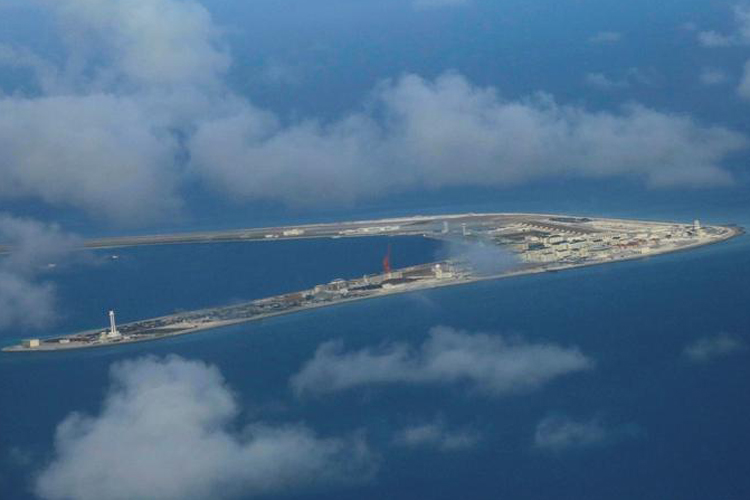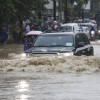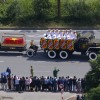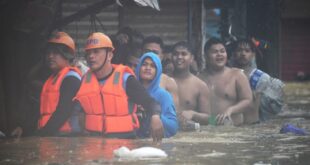China increasing militarization in the East Sea (South China Sea) reveals its intention to further intimidate other littoral states, experts say.
 |
|
An aerial view of Subi Reef illegally occupied by China, April 21, 2017. Photo by Reuters/Francis Malasig |
China has started sending the J-20, its most advanced fighter aircraft, to patrol the East and South China Seas in routine training sessions, Chinese state-run Global Times reported on Wednesday, citing military experts.
Last month, U.S. Indo-Pacific commander Adm. John Aquilino said China has fully militarized at least three of several artificial islands it has built in the South China Sea, arming them with anti-ship and anti-aircraft missile systems, laser and jamming equipment as well as fighter jets, AP reported.
Gregory Poling of the Center for Strategic and International Studies (CSIS), a U.S. think tank, said militarization matters most because of what it allows China to do in peacetime.
The PLA-Navy now regularly rotates its forces through the Spratlys, the China Coast Guard keeps about a dozen boats on patrol every day at Vanguard Bank, at Second Thomas Shoal, Luconia Shoals, and Scarborough Shoal.
About 300 Chinese militia vessels are at anchor in the Spratly Islands each day of the year. All of that is only possible because the vessels can use the archipelago as their forward operating bases, and the result is steady pressure that is pushing Vietnam, Malaysia and the Philippines out of the South China Sea.
Poling said militarization has been a steady development by China, and not something with a clear end point.
The Spratly Islands bases were built between 2013 and 2016, most of the military infrastructure was finished by 2018, and the deployments of navy, coast guard, and militia forces were at their current levels by the end of 2018. By early 2020 China was regularly deploying patrol aircraft to the islands, but has not deployed fighter jets.
According to Carlyle Thayer, emeritus professor, University of New South Wales Canberra at the Australian Defense Force Academy, militarization of artificial islands has allowed China to consolidate its control over the South China Sea.
Thayer said China can at present threaten military and civilian aircraft with its HQ-9 system that fly within 125 km of its artificial islands up to an altitude of 27 km. And China can target surface ships up to 400 km.
“This capability should intimidate littoral states. And in times of conflict, China can target enemy ships and aircraft that transit or overfly the South China Sea.”
Professor Herman Joseph Kraft, the University of the Philippines, said China’s completion of militarization on some islands in the South China Sea makes it more possible for Beijing to increase the capabilities of their coast guard and navy to patrol the area.
It will also enable China to project power to greater distances and longer periods of time within the region.
Kraft predicted that the completion will help China make its presence felt in areas with a larger number of countries in the coming time.
The Philippines and Vietnam have been subjected to harassment and aggressive actions taken by China so far. Malaysia and Brunei have also felt the Chinese presence. Indonesia has faced the same situation on the areas of Natuna Sea.
“We might find that there will be increased Chinese presence in those areas.”
Kraft said stakeholders should pay attention to certain areas that might be of strategic value to China.
He feared that China will try to strengthen its hold or may create an artificial island on Scarborough Shoal, which is not going to be acceptable to the Philippines.
Carl Schuster, a visiting professor at Hawaii Pacific University, said that the U.S. has predicted that China will militarize Scarborough Shoal before 2030, expecting the process to start by 2025.
At present, although China has placed no military equipment or garrison on Scarborough Shoal, maps show the radar cover and weapons coverage China has now established south of Scarborough Shoal and what that coverage will be when it places a garrison and equipment on Scarborough Shoal.
Schuster said the full militarization will improve China’s ability to monitor and control the air space and waters of the South China Sea. China has strengthened its hold on its territorial claims and its ability to enforce its National Maritime Law across the central and northern portions of the South China Sea. It also signals China’s intention to dominate and control those waters and the air space over them.
- Reduce Hair Loss with PURA D’OR Gold Label Shampoo
- Castor Oil Has Made a “Huge” Difference With Hair and Brow Growth
- Excessive hair loss in men: Signs of illness that cannot be subjective
- Dịch Vụ SEO Website ở Los Angeles, CA: đưa trang web doanh nghiệp bạn lên top Google
- Nails Salon Sierra Madre
 VnExpress News The News Gateway of Vietnam
VnExpress News The News Gateway of Vietnam





